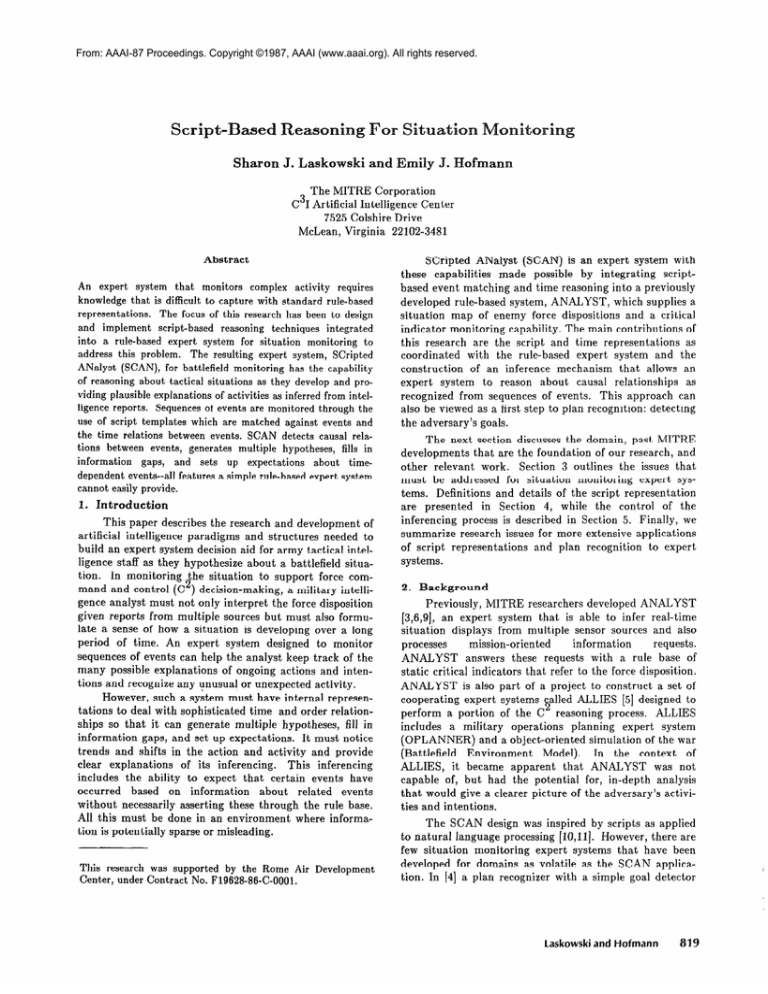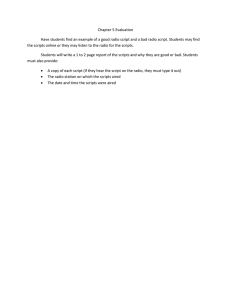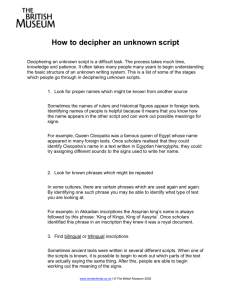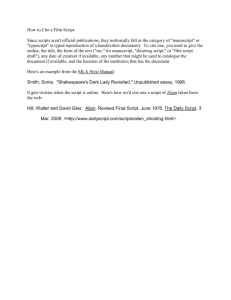
From: AAAI-87 Proceedings. Copyright ©1987, AAAI (www.aaai.org). All rights reserved.
Scripf-Based
easoning
Sharon
J. Laskowski
For Situatio
and Emily
J. Hofmann
The MITRE Corporation
C31 Artificial Intelligence Center
7525 Colshire Drive
McLean, Virginia 22102-3481
Abstract
An expert system that monitors complex activity requires
knowledge that is difficult to capture with standard rule-based
representations.
The focus of this research has been to design
and implement script-based reasoning techniques integrated
into a rule-based expert system for situation monitoring to
address this problem. The resulting expert system, Scripted
ANalyst (SCAN), for battlefield monitoring has the capability
of reasoning about tactical situations as they develop and providing plausible explanations of activities as inferred from intelligence reports. Sequences of events are monitored through the
use of script templates which are matched against events and
the time relations between events. SCAN detects causal relations between events, generates multiple hypotheses, fills in
information
gaps, and sets up expectations
about timedependent events--all features a simple rule-based expert system
cannot easily provide.
1.
IntrocSuction
This paper describes the research and development of
artificial intelligence paradigms and structures needed to
build an expert system decision aid for army tactical intelligence staff as they hypothesize about a battlefield situation. In monitoring the situation to support force command and control (C2) decision-making, a military intelligence analyst must not only interpret the force disposition
given reports from multiple sources but must also formulate a sense of how a situation is developing over a long
period of time. An expert system designed to monitor
sequences of events can help the analyst keep track of the
many possible explanations of ongoing actions and intentions and recognize any unusual or unexpected activity.
However, such a system must have internal representations
to deal with sophisticated
time
and order relation-
ships so that it can generate multiple hypotheses, fill in
information
gaps, and set up expectations.
It must notice
trends and shifts in the action and activity and provide
clear explanations
of its inferencing.
This inferencing
includes
the ability to expect that certain events have
occurred
based
on
information
about
related
events
without necessarily asserting these through the rule base.
All this must be done in an environment where informa-
tion is potentially sparse or misleading.
This research
was
supported by the Rome Air Development
Center, under Contract No. F19628-86-C-0001.
Scripted ANalyst (SCAN) is an expert system with
these capabilities made possible by integrating scriptbased event matching and time reasoning into a previously
developed rule-based system, ANALYST, which supplies a
situation map of enemy force dispositions and a critical
indicator monitoring capability. The main contributions of
this research are the script and time representations as
coordinated with the rule-based expert system and the
construction of an inference mechanism that allows an
expert system to reason about causal relationships as
recognized from sequences of events. This approach can
also be viewed as a first step to plan recognition: detecting
the adversary’s goals.
The next section discusses the domain, past MITRE
developments that are the foundation of our research, and
other relevant work. Section 3 outlines the issues that
must be addressed for situation monitoring expert systems. Definitions and details of the script representation
are presented in Section 4, while the control of the
inferencing process is described in Section 5. Finally, we
summarize research issues for more extensive applications
of script representations and plan recognition to expert
systems.
2.
ackgrouncl
Previously, MITRE researchers developed ANALYST
[3,6,9], an expert system that is able to infer real-time
situation
displays
processes
ANALYST
static
critical
ANALYST
from
multiple
sensor
sources
and also
requests.
information
mission-oriented
answers these requests with a rule base of
indicators
that refer to the force disposition.
is also part of a project
to construct
a set of
cooperating expert systems salled ALLIES [5] designed to
perform a portion of the C reasoning process. ALLIES
includes a military operations planning expert system
an d a object-oriented simulation of the war
(OPLANNER)
(Battlefield
Environment
Model).
In the context of
ALLIES, it became apparent that ANALYST
was not
capable of, but had the potential for, in-depth analysis
that would give a clearer picture
ties and intentions.
of the adversary’s
activi-
The SCAN design was inspired by scripts as applied
to natural language processing [lO,ll].
However, there are
few situation
monitoring
expert systems that have been
developed
for domains as volatile as the SCAN application. In [4] a plan recognizer with a simple goal detector
Laskowskiand Hofmann
for analyzing aircraft threat is described. Blackboard
architectures have been used in domains such as speech
processing, but these do not fully address the problems
that an expert system must handle in a rapidly changing
environment. Fall’s work [8] uses a representation called a
“model” similar to scripts to propagate evidence through
time for situation monitoring, but without a robust interface to a rule-based expert system.
The Ventilator
Manager (VM) program [7] is an example of a MYCIN-like
system with an underlying state transition model for interpreting data in an intensive care unit, but was found to be
to be inadequate for monitoring data continuously over
time. The power of SCAN lies in its ability to monitor
continuously changing situations with missing, inaccurate
and/or deceptive sensor data and analyze multiple adversaries while at the same time preserving the desirable
characteristics of a rule-based expert system.
3.
Motivation
In any situation monitoring expert system applied to
a rapidly changing environment, time becomes an essential
element that must be integrated into the knowledge used
to reason about the situation. The causal relationships
between events and the expectations of events taking place
in specific sequences all play a role in painting a picture of
a situation given partial data about a set of activities. It is
also crucial to have a well-organized history of events to
support any conclusions such a system infers.
ANALYST
is goal-driven
by user information
requests which are static critical indicators represented by
propositions.
Answers to the requests have likelihood
values (Dempster-Shafer likelihood intervals) that indicate
the configuration on the battlefield based on the current
situation map (SITMAF’) of military units. ANALYST can
neither recognize activity as signifying an action developing over several snapshots of the SITMAP nor “bootstrap”
itself into suggesting some explanation of the progress of
the activity and how it relates to other past, present, or
future activities.
While it is possible to place the knowledge about
sequence of events into ANALYST rules, the rules would
be very complex because the sequences are long and the
causal dependencies are not always precisely sequential.
Events have duration and may overlap in many different
ways. Rules would require long chains of antecedents or
long chains of rules to hook up these antecedents.
Knowledge engineering and debugging these rules would
be non-intuitive and quite difficult, and explanations
would be confusing to a user. In other words, the major
benefits of using an expert system technology over more
traditional software techniques would be lost.
For the first design and implementation of SCAN, the
research concentrated on the script knowledge representation and control to illustrate that, indeed, the type of
knowledge described above could be represented simply.
Two major assumptions were made. First, SCAN does no
complicated spatial reasoning; interesting areas on the
situation map are pre-defined based on the current
scenario. This focuses where the major activity is located
820
Expert Systems
and simplifies script searching and matching. The second
assumption is to use the uncertainty representation (likelihood intervals and likelihood probabilities) currently in
ANALYST
with little modification. These assumptions
are re-examined in Section 6.
4.
The Script-Based
Approach
The notion of representing sequences of events as
templates or scripts is analogous to representing stereotypical information
for natural language processing as
explored in Schank’s research [lo]. SCAN is a “goal detector” that could be used to guide the search of a plan recognizer similar to the plan understanding described in [ll].
From the SCAN viewpoint, scripts are sequences of
events, an event being an activity occurring for a specific
duration that is detectable. Each event is described by
another script or a proposition and viewed as an indicator
that the parent script is occurring. We use this script
paradigm to create a knowledge structure that acts as an
event template to be matched against a series of time slices
comprised of SITMAPs and associated inferences.
This matching process is complex for several reasons.
Any tactical maneuver unfolds as a sequence of (possibly)
overlapping steps or events and they must be fit together
like pieces of a puzzle as they are uncovered. Because
events are recognized by SCAN as a discrete measurement
of continuous occurrences, the start and end times of
events are rough approximations. Matching must then
take place based on only guesses as to the ordering and
durations of the events. Some events might not have been
recognized at all.
4.1
The
Script
Knowledge
Structure
The representation for script knowledge was designed
to be expressive enough not only for monitoring and plan
recognition applications, but also for ALLIES planning
and simulation purposes where the impreciseness of sensors is not a problem. For the purpose of this paper, we
illustrate the script knowledge structure and control with
a football example. Although a tactical maneuver in football might last for only a few seconds as opposed to several
hours in the military domain, the matching algorithms
used for monitoring and guessing the adversary’s actions
are similar.
A script knowledge base is stored as a set of lists in a
file which are then accessed through a frame language.
Each script entry has the following format:
(defscript script-name
script-elements-list
script-bindings-list
necessary-preconditions-list
sufficient-preconditions-list
script-analysis)
The script-elements-list contains names of sub-scripts
which are either pointers to other scripts (and may be used
to build up a taxonomy of scripts) or names of propositions which will be monitored as as information requests.
Each element in script-elements-list
has the format:
(defscript
counter-tray-play
(script-name
(nmne
type
bindimge-list
preamnditicona-Bist)
(>
The type is used to specify whether the element is another
script or a proposition. The bindings-list contains variable
names and their values, if present. The bindings are used
to describe the context of the instantiation of a script or
proposition (for example, location, time, or direction of
movement) and the default constants such as the duration
and weight of an event. The preconditions-list has predicates which may refer to the script-name of other scriptelements in the defscript. This preconditions-list is used to
specify entry conditions and time relations between the
event the element represents and the other events in the
parent script. The time predicates are based on Allen’s
temporal language (I$].
The script-bindings-list has the same format as the
bindings-list of the script-elements-list describing the context of the instantiated script.
The two preconditions-lists are made up of predicates
and allow the distinction between necessary preconditions
based on predicates that remain static as opposed to
dynamic preconditions. For example, a necessary precondition for a particular football play could be the team possessing a ,specific capability such as an extremely strong
running back, whereas sufficient preconditions could be
field position, yardage to go, and time remaining in the
game in the current context. This allows greater efficiency
in searching scripts--there is no need to monitor a script in
a context that does not meet the necessary preconditions.
The script-analysis describes the evaluation function
used to determine how well a script matches a current
situation, that is, to calculate its likelihood.
Typical examples of SCAN football script knowledge
are a counter-tray-play and a running-back-fake shown in
Figure I. All time units are in seconds. The counter-trayplay contains six events, two of which are sub-scripts--a
running-back-fake and a quarter-back-fake. An instantiation of the counter-tray-play script has several contextual
bindings: the field location of the play, the direction of
movement, and the time. The likelihood, actual duration,
and currently occurring event are all stored under this
context in a script instance frame.
4.2
Time
Representration
There are several issues in time representation that
must be dealt with in developing a script knowledge
representation and script matching heuristics. Time must
be portrayed in a way that captures the “fuzzinesss’of the
domain. An event must not only be recognized as happening with a certain degree of likelihood, but its start and
end times must be approximated as well. Each event has a
specific duration--it is not enough to postulate a point in
time.
The time formalism developed by Allen [I,21 of time
intervals and relations
between intervals provide a
language well-suited to SCAN’s domain. There are two
items not in this formalism but required by SCAN: the
counter-trsy-play)
(script-elements
((end-in-motion
location
(snarp-ball
(>
> direction
prspoeition
> time (>
duratioaa
progoeition
locstion
> direction
>
time (> duration
((meets end-in-motion)))
(running-back-fake
script
( > location
((after
> direction
snap-bell
(quarter-back-fake
(> location
((equsb
> time)
I)))
script
> direction
>
time)
~~~~i~g-~~~~-f~~e)))
(tackbpuli
propositioxn
(>locdhm
((OVdZ3~B
>diaectisn
>time
quarter-back-fake
(guard-pull
2))
(>duratio~1
0.6)))
paopoaition
(> llocatioln > direction
((equals tabckle-pull))))
> time
(bindings
(> location
> direction
(neceessbsy-preconditions
t)
(>
duration
2))
> time))
ccient-precowditione
(offeneive-posture
short-yardage))
(ecript-a~aiyeie
time-abvesa@led-script-BikeBiltaso
(defmript
running-back-fake
(script-name
running-back-fake)
((~~~~i~g-~~~~-t~r~~
proposition
(script-elemerntsl
(>loeation
>directiow
>time
((running-bss@k-kceversera
(>dwatiow
(> 10ca&i0~1
> direction
> time (> duration
((meete running-back-turns
))))
(bindiwge
(> location
> direction
> time))
(neceasarry-preconditions
t)
ent-precsditions
0.5)))
pssposition
0.5))
(0
duration of an event--how long (doctrinally) an event is
supposed to occur and relative start times between events.
Allen’s theory of time is supported by an intervalbased temporal logic and a set of properties that can hold
over the intervals. In SCAN, the notion of the time of an
event is described by a temporal interval, (t , t2) where tI
is the start time and t is the end time of t tl e occurrence.
There is a basic set of &ations that can hold between temporal intervals. “Meets” is a primitive relation such that if
interval i meets interval j, i’s end time is equal to j’s start
time. Twelve other relations can be described in terms of
meet, such as: after, overlaps, equals, meets, and during.
For example, in Figure 1, the tackle-pull overlaps the
quarter-back-fake by .5 seconds.
We have assumed that the script-elements-list in the
defscript is ordered by increasing values of the start times
of the script-elements and hence some time relations are
implicit. As a result, it is not necessary to list all time
relations in the preconditions of an element, only those
that cannot be inferred from the preceding element’s
preconditions and its preceding elements, given the duration information. This simplifies the SCAN scripts and is a
Laskowski and Hofmann
search
scripts that match the current situation.
are script-context-pairs
with a.11preconditions met and likelihoods greater than the scriptoccurring-cutoff, that is, the scripts that appear to best
assess the situation.
natural way to present the script knowledge, but the relations could be made entirely explicit if this was desirable
for a different application.
6.
Control
for
Active-scripts
Architecture
Figure 3 shows the control flow of SCAN and how it
interfaces with the sensor fusor and request processor. Initially, ANALYST applies its fusion rules to reports creating units on the SITMAP.
Then, the monitored-scripts
list is constructed by searching all scripts on all predefined areas of interest for those scripts whose necessary
preconditions are met. As a script is added to the list, all
script-elements that are propositions are set up as information requests whose values will be monitored across
time slices. The initial processing of the requests for the
first time slice involves backward chaining to calculate all
their likelihoods.
The contro1 architecture shown in Figure 2 consists of
the script inference procedure which includes a script
matching function and monitoring facilities. The heart of
SCAN lies in the script control. At the end of an
ANALYST cycle, that is, reading in a set of reports, creation of a times slice from data fusion, and calculation of
the status of the information requests (propositions from
script-elements) the script control evaluates the status of
the scripts, noting new scripts that have started up and
monitoring the likelihood of the scripts already being monitored. All rule-based inferencing is done through the
request processing under the guidance of the script control.
After the initialization, the active-scripts list is built
by searching through the monitored-scripts for scripts
whose sufficient preconditions are met, calculating a likelihood for each of those scripts and placing a script on the
active-scripts list if its likelihood is high enough.
As the SITMAP is monitored, each script must be
matched against a particular context and time. These two
values are used as a key for storing and retrieving the
inferences about a script and its associated sub-scripts and
propositions. When a script is matched for the first time, it
is instantiated with a likelihood.
When the monitoring phase is entered, a new time
slice is built and all information requests are re-evaluated
for changes through a forward chaining inference procedure. (Only rules that will alter the likelihoods of the
current information requests are fired.) With the updated
information available, each active script is re-evaluated to
update its likelihood and determine if it should remain
active. Because new scripts might be starting up at any
point, the monitored-script-list is examined again. At any
point in time, the active-scripts can be interpreted as a set
of hypotheses that explain the enemy’s intentions.
Script likelihood is used to compare how well a script
matches the situation relative to other scripts. The likelihood value is between 0 and 1, and a script is typically
considered to be occurring if the value is greater than .5.
This cutoff value is called the script-occurring-cuto~. As
likelihoods change from time slice to time slice, they are
stored using the script instance’s context and the current
time so that a history is maintained.
The start and end
times of scripts and propositions, as well, are calculated
based on when the likelihood is above the cutoff.
Script likelihood calculation is based on the likelihoods of the script-elements, the time relations between
elements, the history of likelihood values, and a currentelement-pointer
denoting the script-element in progress, if
As SCAN operates, it maintains two lists of scripts.
Monitored-scripts
list are script-context pairs whose necessary preconditions are met. This list is used to guide the
(State/
Script
Control
I
AI
-*-I---,
- J
1
I
Request
Processing
I
Information
Requests
Replies/Updates
c
T‘
I
/
Data
Fusion
4
---m-
Status
Reports
-
Environment
Model
SCAN
Expert Systems
I
Replies/
Information
Requests
$22
‘I
Figure 2
System Architecture
-
-
Color
Sitmap
Display
_.-.-_._-..
T)PI ANNER
\
J
I
ANALYST
Functions
A goal for SCAN (and one reason for wanting intuitive knowledge representations) is to allow the expert to
knowledge engineer SCAN directly. A knowledge editor
with a sophisticated human-machine interface would be a
step closer to achieving this.
Finally, SCAN represents only part of the software
that is necessary to generate and recognize details of plausible plans. Future work includes building a plan recognizer based
on the planning
techniques
in the
OPLANNER plan generator and guided by SCAN’s script
hypotheses to constrain the plan search space.
Initialization
References
-l
I
Monitored
Scripts
I
SCAN
I
J
PI
Allen, J. F., Towards a general theory of action and
time, Artificial Intelligence 23 (1984) 123-154.
PI
PI
Allen, J. F. and Hayes, P. J., A common sense theory
of time, IJCAI (1985) 528-531.
Antonisse, H. J., Bonasso, R. P., and Laskowski, S. J.,
ANALYST II: a knowledge-based intelligence support
system, MITRE Technical Report MTR-84WOO220,
April 1985.
PI
Azarewicz, J., et. al., Plan recognition for airborne
tactical decision-making, AAAI (1986), 805-811.
PI
Benoit, J. W. et. al., An experiment in cooperating
expert systems for command and control, Expert Systems in Government Conference, October 1986.
PI
Bonasso, R. P., ANALYST:
An expert system for
rmy Conference
processing sensor returns, The First
3
on Knowledge-Based Systems for C I, Army Model
Management
Office, Ft. Leavenworth,
November
1981, 219-245.
I
FIgure 3
Script Control
Flow
171 Buchanan,
Based
combined to determine a script’s overall likelihood using
weights specified in the bindings-list of the script and the
function (for example, averaging) specified in the scriptanalysis.
6.
Conclusions
and Future
Co.,
1984.
PI
Fall, T. C., Evidential reasoning
aspects, AAAI (1986) 891-895.
PI
Laskowski, S. J., Antonisse, H. J., and Bonasso, R. P.,
ANALYST II: A knowledge-based intelligence support system, Second IEEE Conference on Artificial
Intelligence Applications, December 1985, 552-563.
Directions
Scripts
do, indeed, provide a more intuitive
knowledge representation for situation monitoring expert
systems. SCAN as an implementation
of the script
mechanism is able to recognize trends on the battlefield.
SCAN has a time representation and an interface to the
rule-based ANALYST system that allows it to focus on the
development of activities over time. However, additional
experimentation
is needed to explore the knowledge
engineering of scripts. SCAN, at present, is very limited
in its number of scripts and its matching techniques.
B. G., and Shortliffe, E. H., eds., RuleSystems,
Addison-Wesley Publishing
Expert
[lo] Schank, R. and Abelson, R. Scripts,
Understanding,
Lawrence Erlbaum
with
Plans,
temporal
Goab
Associated,
and’
Inc.,
1977.
[ll]
Wilensky, R, Planning
tational
Approach
and Understanding:
to Human
Reasoning,
A Compu-
Addison-
Wesley Publishing Co., 1983.
The assumptions that have been made for this first
version of SCAN need to be re-examined if SCAN is to be
more that a toy system. Spatial and terrain reasoning is an
important aspect of SCAN’s domain yet has been virtually
ignored. The techniques for reasoning about uncertainty
are quite ad hoc and should be changed to a representation
with a firmer mathematical footing to avoid inconsistency
and potential anomalies.
Laskowski and Hofmann
823






